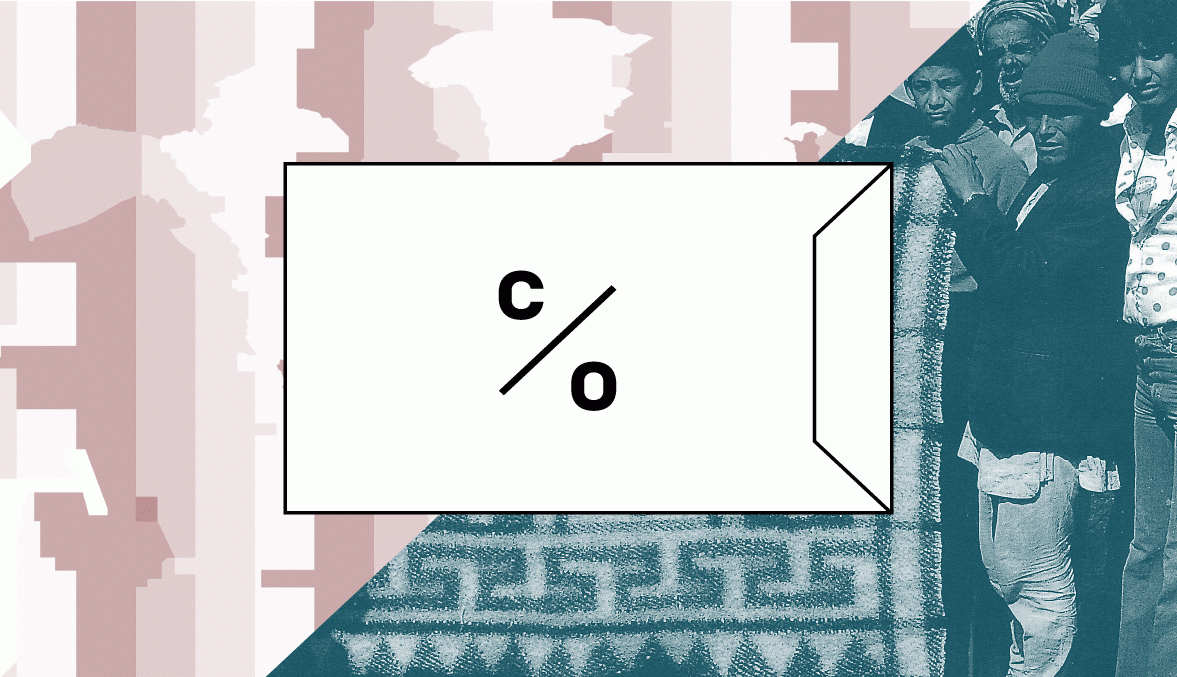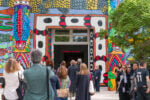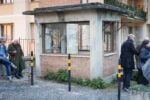c/o – an alternate correspondence #4

1/9unosunove è lieta di presentare Kasper Bosmans c/o Raffaella Crispino – an alternate correspondence, la quarta e ultima mostra del ciclo curato da Marianne Derrien.
Comunicato stampa
1/9unosunove è lieta di presentare Kasper Bosmans c/o Raffaella Crispino – an alternate correspondence, la quarta e ultima mostra del ciclo curato da Marianne Derrien. Il dialogo e la corrispondenza tra Crispino (Napoli, 1979) e Bosmans (Lommel, 1990) è iniziato un anno fa durante il periodo di residenza all’HISK in Belgio. La mostra che hanno concepito congiuntamente per 1/9unosunove esplora la relazione tra tempo e cultura, tra la storia personale e quella collettiva, tra la narrazione e i sistemi di pensiero.
Crispino e Bosmans hanno realizzato insieme l'opera Fountain, l’installazione principale della mostra. Ispirata a un video su Youtube raffigurante la costruzione fai da te di un moto perpetuo, la scultura è il risultato di questo ingenuo e inesperto tentativo, il cui obiettivo utopico è quello di creare qualcosa che eviti di riferirsi al tempo, ma che in realtà rivela come la misura di questo sia inevitabile. Attraverso questa macchina-fontana – realizzata con una bizzarra rete di tubi di plastica appesa al soffitto della galleria e riempita con acqua corrente – viene evocata la realizzazione di una antica utopia, indagando le sue possibilità estetiche e le sue potenzialità o i suoi fallimenti fisici.
Riarticolando il flusso del tempo e dello spazio nella mostra, Fountain offre lo spunto per una correlazione al nuovo corpo di lavori di Raffaella Crispino. Untitled (time zones), una tenda d’organza lunga e leggera che rappresenta il planisfero dei fusi orari realizzato con la tecnica del patchwork, si riferisce alle regole geopolitiche dettate dai sistemi economici e dagli interessi politici attraverso una dimensione sensuale e poetica. Questo progetto dialoga con Samia, un’installazione di tessuto che si riferisce alla giovane atleta somala Samia Yusuf Omar morta nel 2012 a bordo di un’imbarcazione clandestina al largo della Sicilia nel tentativo disperato di raggiungere le Olimpiadi di Londra. Composta da tessuti africani e una toile de Jouy con il tema Les Plaisirs de la campagne nel quale Crispino dipinge di nero i personaggi, l’installazione è un omaggio critico ai sogni persi, alla clandestinità e al dramma quotidiano delle navi che affondano lungo le coste della Sicilia, alla sfida e alla speranza.
Considerando la nostra relazione ciclica con il tempo e lo spazio, Crispino s’interroga sulla reinterpretazione storica e sull'alterazione delle interpretazioni personali. Ideato e realizzato a Bruxelles, Ceci n'est pas un livre è un lavoro legato alla nostra possibilità di entrare e uscire dal sistema artistico. Ognuno dei tre volumi è costituito unicamente dai frontespizi di libri di generi diversi. Pagina dopo pagina, i titoli annunciano un libro che non sembra mai iniziare, ma che comunque conduce il lettore attraverso una storia particolare collegata al sistema dell'arte, come fosse una richiesta di permanenza e continuità.
Con un approccio antropologico intuitivo, il giovane artista belga Kasper Bosmans guarda alle tradizioni socio-culturali che caratterizzano l'arte e ciò che ci circonda. Osservazioni e disegni specifici di un contesto – del mondo naturale, dei costumi popolari, o dei materiali locali - ispirano la sua ricerca artistica. Bosmans ha una predilezione per l’utilizzo di diversi media, dalla pittura al disegno e all'ingegneria; ma anche per letture interdisciplinari di rituali etnografici, per la filosofia del primo Rinascimento e per i romanzi fin-de-siècle.
Legend è una serie di cinque gouache su legno che tenta di chiarire le procedure utilizzate per la creazione dei lavori presentati in mostra. Bosmans accompagna il suo lavoro con spiegazioni visive relative al contenuto o al processo. Come una legenda, l’opera fornisce le chiavi di lettura per un'interpretazione alternativa del progetto. Legend, riprendendo elementi da altre opere, gioca un ruolo importante anche in Pearls and Waves. Fatta di tessuto, quest’opera riproduce il motivo cintamani, una decorazione a onde di perle e gemme derivata dalla fantasia delle stoffe tigrate, che si credeva avere un influsso benefico sulla vita di chi la guardasse. Originariamente la pietra cintamani, come la pietra filosofale occidentale, era di quelle che realizzano i desideri, e che svolse un ruolo fondamentale nelle società indù e buddiste. Il motivo decorativo divenne simbolo di potere e di lusso tra i potenti ottomani, e fu utilizzata come stendardo nella battaglia di Lepanto. Alcuni studiosi ritengono che questo motivo indu-buddista sia stato utilizzato in maniera ironica dai governatori islamici dell'Impero Ottomano. Provenendo dal Nepal, dove l'artista ha tessuto Pearls and Waves, l’opera è transitata per Dubai, poi ad Anversa e infine a Roma, raccontando la storia di questo spostamento nel tempo e nello spazio.
Come risultato del loro dialogo e della loro comune ricerca, il video di Bosmans, O mio babbino caro, Maria Callas, sembra rispondere al video di Crispino Quand on s'aime che mostra Michel Legrand e Nana Mouskouri che cantano la stessa canzone in due diversi momenti della loro vita. Allo stesso modo, il film di Bosmans è una raccolta di stralci di performance dal vivo della famosa opera di Puccini. La somiglianza dei gesti registrati nel corso degli anni è accentuata dalla rimozione del sonoro dal video.
Raffaella Crispino (Napoli, 1979) attualmente vive e lavora a Bruxelles. Tra le recenti mostre personali:
Our Audience, Maison d’Art Actuel des Chartreux, Brussels, Belgio (2013); Weather Forecast, L’Ozio, Amsterdam, Olanda (2013); 200 Différents Oiseaux, 1/9unosunove, Roma (2011); Transit 3, a cura di A. Rispoli, M. Sheleff e E. Viola, CCA-Tel Aviv , Museo MADRE, Napoli (2009). Tra le collettive: Èdra, Connecting Landscapes, a cura di C. Stolfi, American Academy, Roma (2014); Répétition Générale, 1/9unosunove, Roma (2014); Towards which planet?, R. Gavarro curator, Canal05, Brussels, Belgio (2014); Art’Contest, De Markten, Brussels, Belgio (2013).
Kasper Bosmans (Lommel, 1990) attualmente vive e lavora a Bruxelles (Belgio). Tra le recenti mostre personali: Made to Measure: Fishing Rod, Experimental Intermedia, Ghent, Belgio (2014); Summary; fox, milk, smoke, Kasper Bosmans, Galerie Tatjana Pieters, Ghent, Belgio (2014); Kasper Bosmans & Philippe Van Snick, Nightshop, con Galerie Tatjana Pieters, Knokke, Belgio (2013). Fra le collettive: ATLAS, Motinternational, Bruxelles, Belgio (2014); Het Vierkantigste Rechthoek, Kunsthal Kade Amersfoort, Paesi Bassi (2014); Raving Disco Dolly on a Rock N’ Roll Trolley, Envoy Enterprises, New York, Stati Uniti (2014); INBOX, A4 Multiple (4) van Lode Geens, M HKA, Antwerp, Belgio (2014); Belgium Performance Festival, Koninklijke Academie voor Schone Kunsten & MuHkA, Antwerp, Belgio (2013); The New Candour!, Galerie Tatjana Pieters, Ghent, Belgio (2012).
Marianne Derrien. Nata nel 1981 a Berlino, curatrice e critico d’arte residente a Parigi, Marianne Derrien ha lavorato presso la galleria Serge Le Borgne a Parigi ed è stata Addetta per le mostre all’Accademia di Francia a Roma – Villa Medici. Attualmente è capo-redattrice del sito internet e coordinatrice del Point Perché by The Absolut Company, nuovo spazio del Palais de Tokyo a Parigi. La sua pratica curatoriale si concentra sull’analisi contestuale di un territorio e della sua storia sociale, politica e sociologica attraverso le testimonianze / confessioni / micro-storie, la mentalità e il linguaggio del corpo nell’ambito di un contesto privato o politico.
La mostra proseguirà fino a Sabato 11 aprile 2015.
/////////////////////////////////////////////////////////////////////////////////////////////////////////////////////////////////////////////////////////////////////////
English version
Friday, February 20, 2015 - 7pm
1/9unosunove
is pleased to announce the opening of
Kasper Bosmans
c/o
Raffaella Crispino
a show part of the cycle
c/o - an alternate correspondence
curated by Marianne Derrien
1/9unosunove is thrilled to present Kasper Bosmans c/o Raffaella Crispino – an alternate correspondence, the fourth and last exhibition in the cycle curated by Marianne Derrien. The dialogue and correspondence between Crispino (Naples, 1979) and Bosmans (Lommel, 1990) began one year ago when they met through the Hisk residency program in Belgium. The exhibition they have conceived at 1/9unosunove examines the relation between time and culture, personal and collective History, narration and systems of thought.
Crispino and Bosmans have created together a common artwork, Fountain, main installation of the exhibition. Inspired by a Youtube footage of a DIY construction of a perpetuum mobile, the sculpture is the result of a naïve attempt to generate the moto perpetuo, which utopic goal is to create something that will avoid referring to time but that actualy reveals that the metric of times are unavoidable. This indoor fountain-machine, made of a bizarre network of plastic tubes hung to the ceiling of the gallery, filled with running water, evokes this former utopia investigating its aesthetic possibilities and physical capacities or failures.
Re-articuling the flux of time and space during the exhibition, this common piece offers a correlation with Raffaella Crispino's new body of work. Untitled (time zones), a long and light organza curtain, representing a colored planisphere of the time zones, made with the technique of the patchwork, relates to the geopolitic rules motivated by economic systems and political interests through a sensual and poetic dimension. This piece dialogues with a second work, an installation with various fabrics entitled Samia, refering to the young Somali athlete Samia Yusuf Omar who died in 2012 on a clandestine boat in front of Sicily on her desperate way to participate to the London Olympics. Made with african cloth and toile de Jouy fabric representing the theme of Les Plaisirs de la campagne in which Crispino has colored the characters in black, the installation acts like a critical tribute to lost dreams, clandestinity and the everyday drama of the sinkings ships off the coasts of Sicily, challenge and hope.
Considering our relationship to time and to space as a loop, Crispino questions the historic reinterpretation and the alteration of personal interpretations. Conceived and produced in Brussels, Ceci n'est pas un livre is a piece related to our possibility to get in or out of the artistic system. Each of the three volumes consists only of title pages from books of multiples genres. Page after page, the titles announce a book which seems to never begin but that nevertheless brings the reader to a singular history connected to the system of art as a request of permanence and continuity.
With an intuitive anthropological approach, young Belgian artist Kasper Bosmans looks towards the sociocultural traditions that shape art as well as our surroundings. Context-specific observations and designs — related to the natural world, popular customs, and local materials — inspire his artistic practice. Bosmans has a predilection for wide-ranging mediums, such as painting, drawing, and engineering, as well as for interdisciplinary readings of ethnographic rituals, early Renaissance philosophy and fin-de-siècle novels.
Legend is a series of five gouaches on wood that attempts to clarify the procedures used to create all works that were included in the exhibition at the gallery. Bosmans accompanies this work with visual explanations of both the content and the process. Acting like a legend, it becomes a work of its own and gives keys to an alternative interpretation of the project. Showing elements from other works in show, Legend plays a major role in another work on view entitled Pearls and Waves. The fabric artwork reproduces the cintamani decorative pattern, a wavy motif of pearls and gems, possibly derived from a woven tigerpattern, which was believed to have a positive influence on the life of the beholder. According to the tradition, the cintamani stone is a wish-fulfilling gem that played an significant role in both Hindu and Buddhist society. The pattern got appropriated as a symbol of power and luxury by the Ottoman rulers and even functioned as a flag during the battle of Lepanto. Some scholars believe the Hindu-Buddhist motif was used in an ironic way by the Islamic rulers of the Ottoman Empire. Coming from Nepal where the artist had it woven, transited to Dubaï, then to Antwerpen and now in Rome, Pearls and Waves also tells the story of this displacement in time and locations.
As a result of their dialogue and common researches, Bosmans’ video O mio babbino caro, Maria Callas, seems to reply to Crispino's video Quand on s'aime showing Michel Legrand and Nana Mouskouri singing the same song in two different moments of their life. In the same way, Bosmans’ footage is an excerpts' compilation of live performances of Puccini’s famous opera. The similarity of the gestures recorded over the years is accentuated by removing all sound from the video.
Raffaella Crispino (Naples, 1979) currently lives and works in Brussels. Recent solo exhibitions include: Our Audience, Maison d’Art Actuel des Chartreux, Brussels, Belgium (2013); Weather Forecast, L’Ozio, Amsterdam, Holland (2013); 200 Différents Oiseaux, 1/9unosunove, Rome (2011); Transit 3, curated by A. Rispoli, M. Sheleff e E. Viola, CCA-Tel Aviv, Museo MADRE, Napoli (2009). Recent group exhibitions: Èdra, Connecting Landscapes, C. Stolfi curator, American Academy, Rome (2014); Répétition Générale, 1/9unosunove, Rome (2014); Towards which planet?, R. Gavarro curator, Canal05, Brussels, Belgium (2014); Art’Contest, De Markten, Brussels, Belgium (2013).
Kasper Bosmans (Lommel, 1990) currently lives and works in Brussels (Belgium). Recent solo exhibitions: Made to Measure: Fishing Rod, Experimental Intermedia, Ghent, Belgium (2014); Summary; fox, milk, smoke, Kasper Bosmans, Galerie Tatjana Pieters, Ghent, Belgium (2014); Kasper Bosmans & Philippe Van Snick, Nightshop, with Galerie Tatjana Pieters, Knokke, Belgium (2013). Recent group exhibitions: ATLAS, Motinternational, Brussels, Belgium (2014); Het Vierkantigste Rechthoek, Kunsthal Kade Amersfoort, Netherlands (2014); Raving Disco Dolly on a Rock N’ Roll Trolley, Envoy Enterprises, New York, USA (2014); INBOX, A4 Multiple (4) van Lode Geens, M HKA, Antwerp, Belgium (2014); Belgium Performance Festival, Koninklijke Academie voor Schone Kunsten & MuHkA, Antwerp, Belgium (2013); The New Candour!, brought together by Hans Theys, Galerie Tatjana Pieters, Ghent, Belgium (2012).
Marianne Derrien. Born in 1981 in Berlin, independent curator and art critic based in Paris, Marianne Derrien worked as assistant at Serge Le Borgne 's gallery - Paris and was Project Manager for the exhibitions at the French Academy in Rome – Villa Médicis. Currently, she is editor-in-chief of the web site and coordinator of le Point Perché by The Absolut Company, new space in the Palais de Tokyo, Paris. Her curatorial practice is structured by the contextual analysis of a territory and its social, political and sociological history through testimonies / confessions / micro-history, mind control, body language within a personal or political context.
The exhibition will be open until Saturday, April 11, 2015



